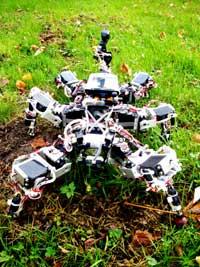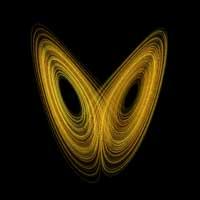Chaotic cockroach
2010/02/14 Kortabitarte Egiguren, Irati - Elhuyar Zientzia

The AMOS robot consists of six legs, 18 motors to control the movement of the legs and 18 sensors to inform about the heat, luminosity and contact with the floor. The aim of the researchers was to develop a conventional processor capable of adapting quickly and automatically to the changes that occur in the environment of the robot's march. Any behavior of a robot, such as changing gear, is a difficult and laborious job. Each type of gear requires a hardware to control and govern the behavior of the robot. To achieve this goal, German researchers have based themselves on the theory of chaos.
Theory of chaos

According to the theory of chaos, systems are very sensitive to small changes that, in turn, can cause great changes. That is, small events in dynamic environments can cause great changes. The research "The Theory of Chaos" revolutionized science. Edward Lorenz, an American meteorologist, explained the chaos. Therefore, it is common to quote a study of meteorologist Lorenz as one of the first examples of chaos. To date, this theory is solving many difficult problems without solution or solution, and today there are researchers from many scientific faculties around the world who are working in this scientific field. Most may have the same question: Is it possible to obtain order from chaos? According to scientists, many natural phenomena, apparently ordered, have occurred thanks to a structure of chaos.
On this occasion, German researchers have built a simple circuit to overcome some complex behaviors of the robot AMOS. The processor of this circuit uses a chaotic algorithm to create and classify possible changes, immediately eliminating improper changes.

The combination of chaos theory and robotics can have medical applications. ... (Archive).
Thanks to this chaos control technique, the AMOS robot can travel through rough and rough lands, escape predators and choose an energy saving march when the slope rises. It is also able to maintain balance when it loses balance or puts the foot in a hole and pull the foot out of the hole.
The researchers have found that this combination between the theory of chaos and robotics can help to understand the movements of animals and that it can have medical applications such as epilepsy, parkinson's disease, or the stabilization of damaged neuronal activity in patients with migraines. Among other things, German researchers investigate some of the waves that occur in the brain before the appearance of migraines, as they believe or believe that certain reactions that occur in the brain in healthy people eliminate those waves. Therefore, it is possible that in the future control of chaos is used to remove these waves.
Published in 7k

Gai honi buruzko eduki gehiago
Elhuyarrek garatutako teknologia





